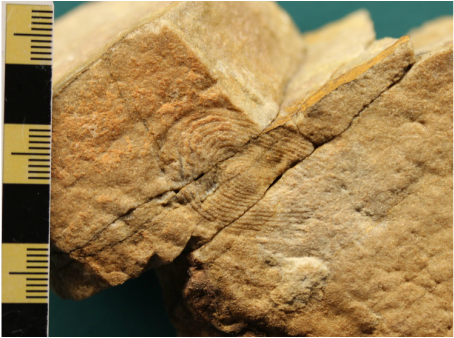ovatoscutum concentricum
glaessner and wade, 1966
|
Ovatoscutum shares a similar body plan to the genera Dickinsonia and Yorgia, with closely spaced transverse body units that swept backwards towards its 'posterior', and an 'anterior' section shaped like a half-moon.
Ovatoscutum concentricum has been tentatively compared with living vellelid floats (free-living hydrozoa, relatives of jelly-fish and corals) from the Phylum Cnidaria (Glaessner & Wade, 1966), but some researchers have questioned whether it is a valid taxon. A contemporary morphological analysis is overdue. Described from: Flinders Ranges, South Australia White Sea, Russia Podolia, Ukraine |
|
Taxonomic diagnosis (Glaessner & Wade, 1966):
A large, rounded shield sculptured with strong concentric corrugation, which weakens adjacent to a triangular notch, where the outline of the shield is indistinct in the only known specimen. The centre of the sculpture, a minute, smooth, oval, convex area, is situated at a distance of about one-third of the length of the shield measured from a line across the extreme ends of the notch. The contour of the ribbing changes from distinctly elongate at a length of 2-2.5 cm to almost equal in length and width, but it becomes sinuous rather than circular. A suture-like zone about 1 mm wide extends through the centre from the tip of the notch towards the opposite margin.
A large, rounded shield sculptured with strong concentric corrugation, which weakens adjacent to a triangular notch, where the outline of the shield is indistinct in the only known specimen. The centre of the sculpture, a minute, smooth, oval, convex area, is situated at a distance of about one-third of the length of the shield measured from a line across the extreme ends of the notch. The contour of the ribbing changes from distinctly elongate at a length of 2-2.5 cm to almost equal in length and width, but it becomes sinuous rather than circular. A suture-like zone about 1 mm wide extends through the centre from the tip of the notch towards the opposite margin.

